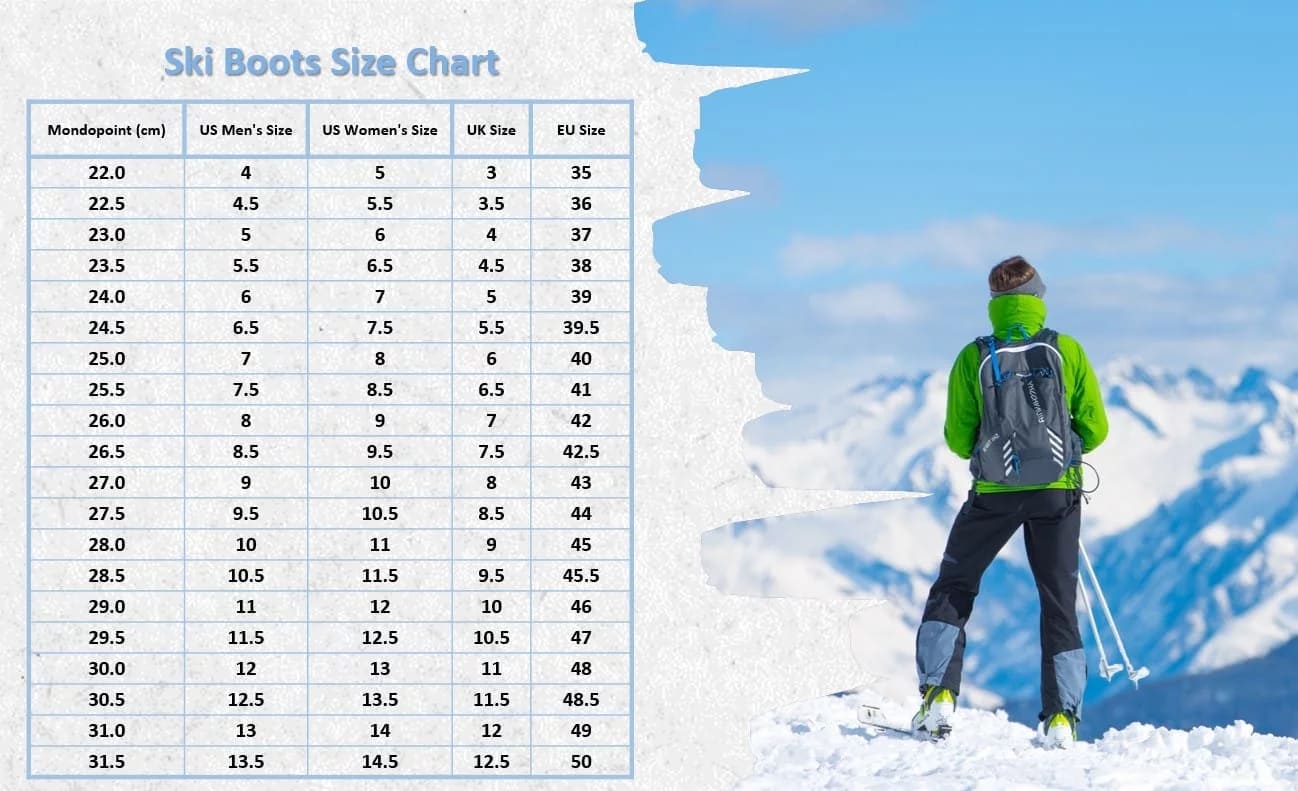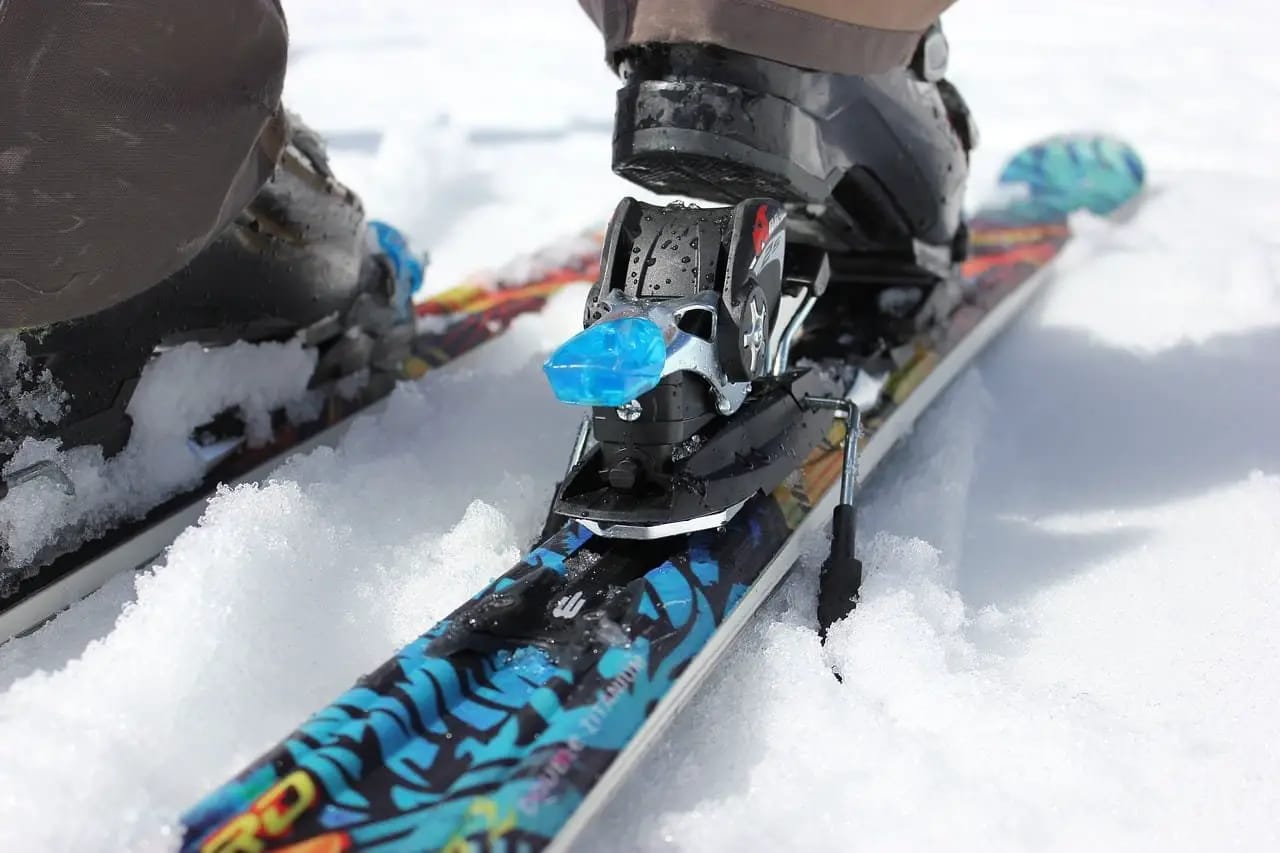Introduction to Ski Boots Size Chart
Imagine gliding down snowy slopes with the grace of an eagle in flight—this is the dream of every skier. But to turn this dream into reality, the right ski boot size is as crucial as the wings to the bird. Here, we introduce the indispensable tool for every skier: the ski boots size chart.
Why Correct Sizing is Essential
Have you ever wondered why seasoned skiers are so particular about their boot size? It’s simple: a precise fit is the linchpin for control and comfort on the slopes. Too tight, and you’re in for a world of pain; too loose, and you might as well be skiing in your slippers. That’s where a ski boots size chart comes into play, ensuring your choice is neither a hit nor miss but a guarantee of a snug, safe, and performance-enhancing fit.
The Ski Boots Size Chart Decoded
A ski boots size chart isn’t just a random collection of numbers and letters—it’s the blueprint to your best skiing experience. By using this chart, you align your foot’s length and width with the ideal boot size, avoiding the common pitfalls of mismatched sizing. Remember, in the world of skiing, precision is not just a preference; it’s a necessity.

Understanding the Ski Boots Size Chart
When it comes to conquering the slopes, the fit of your ski boots can make or break your experience. A ski boots size chart is your roadmap to comfort, control, and confidence as you navigate the snowy terrain. But why is this chart so crucial, and how can you decode its numbers and symbols to find your perfect fit?
The Essence of Accurate Sizing
The ski boots size chart is more than just a table of numbers; it’s a precision tool that ensures your boots will be a natural extension of your body. Ski boots that fit poorly can lead to a host of problems, from blisters and discomfort to reduced control and potential accidents. The size chart takes into account not just the length of your foot but also its volume, which is vital for a sport that demands both finesse and firmness.
Step into the Chart: A Closer Look
At first glance, a ski boots size chart can seem like an enigmatic puzzle. It typically lists sizes in both mondopoint (the length of your foot in centimeters) and standard US and European sizes. The key to unlocking its secrets is understanding that mondopoint is the industry standard for ski boots, offering a more precise and uniform measurement.
By using the chart, you’re not just selecting a size; you’re ensuring that every turn and carve is backed by boots that are in tune with your movements. Imagine them as your dance partner in a waltz down the mountain—when the fit is right, the performance is harmonious.
The Importance of Precision
Using the ski boots size chart is essential for accuracy in sizing. It’s not enough to know your regular shoe size; the chart guides you to a more specific fit that accounts for the unique demands of skiing. Remember, in this sport, precision is not just a preference—it’s a necessity.

How to Use the Ski Boots Size Chart
Navigating the ski boots size chart is like following a treasure map; it leads you to the prize of unparalleled comfort and control on the slopes. Here’s a step-by-step guide to help you measure your feet with precision and match them to the perfect boot size.
Step-by-Step Guide to Precision
- Measure Your Foot: Begin by placing a sheet of paper against a wall. Stand on it with your heel touching the wall, and mark the longest part of your foot. Measure this length in centimeters to find your mondopoint size.
- Find Your Size on the Chart: With your mondopoint measurement in hand, locate the corresponding size on the ski boots size chart. This will give you a starting point for your boot size.
- Check the Width: Ski boot width, or last, is just as important as length. A good fit accommodates the width of your foot without squeezing or leaving too much room.
Tips for Accurate Measurements
- Measure in the Afternoon: Feet tend to swell slightly throughout the day, so measuring later ensures a size that will be comfortable at all times.
- Wear Ski Socks: For the most realistic measurement, wear the socks you’ll ski in. They can affect the fit of your boot significantly.
- Consider Both Feet: Often, one foot is slightly larger than the other. Measure both and use the larger size to find your ideal boot.
Factors to Consider when Using the Ski Boots Size Chart
Selecting the right ski boot is more art than science. While the size chart is your canvas, several factors paint the final picture of the perfect boot.
The Role of Foot Width
Foot width, or the last, is pivotal in ski boot sizing. Boots that are too narrow can restrict blood flow and cause pain, while those too wide may not provide enough support. It’s a delicate balance between snugness and spaciousness.
Comfort vs. Performance
Comfort and performance are the yin and yang of ski boot sizing. While comfort is crucial, a boot too relaxed may sacrifice precision. The ski boots size chart helps you strike a balance that enhances your performance without compromising on comfort.
The Impact of Skier’s Skill Level on Boot Size
Are you a novice or a black-diamond expert? Skill level influences boot size because advanced skiers often prefer a tighter fit for better control at high speeds. Beginners might opt for a bit more room for comfort as they learn the ropes.
Consideration of Comfort and Performance
It’s a delicate dance between comfort and performance. Too tight, and you’ll be wincing down the slopes; too loose, and you’ll lose precision in your turns. Aim for a fit that hugs your foot, locks in your heel, and allows your toes to wiggle just a tad.
Common Mistakes to Avoid when Using the Ski Boots Size Chart
Overlooking the Importance of Trying Boots On
Charts and measurements are starting points, but the true test is slipping your foot into the boot. Always try on boots to ensure the chart’s accuracy translates to real-world comfort and fit.
Ignoring the Significance of a Proper Fit
A proper fit isn’t just about comfort; it’s about safety and performance. Disregarding the nuances of a good fit can lead to blisters, cold feet, or even accidents. When in doubt, consult with a professional boot fitter.

Conclusion: Embracing the Precision of the Ski Boots Size Chart
As we carve our way to the end of this insightful journey, let’s pause and reflect on the pivotal role the ski boots size chart plays in enhancing your alpine adventures. Much like a compass in the wilderness, a ski boots size chart is your guide to navigating the vast terrain of options, ensuring you embark on your snowy escapades with confidence and comfort.
Why the Size Chart is Your Slope Sidekick
Imagine stepping onto the powdery slopes, your boots a perfect extension of your ambition. That’s the magic the size chart weaves. It’s not just about avoiding the pinches and pains; it’s about harmonizing your gear with your goals. When your boots fit as if they were molded just for you, every turn becomes a testament to the precision of the ski boots size chart.
So, dear skiers, as you stand at the precipice of your next downhill challenge, remember the chart. Let it guide you to the boots that will be your partners in every epic tale of alpine conquest. And when you do, you’ll not just ski; you’ll soar.
FAQ Section
1. What is a ski boots size chart and why is it important?
Think of a ski boots size chart as your personal guide to finding the Cinderella fit for your ski boots. It’s a table that translates your foot measurements into the appropriate ski boot size. Now, why is it so crucial? Well, in skiing, the right boot size is everything. It ensures that you have control over your skis, keeps you comfortable on the slopes all day, and helps prevent injuries. It’s like the foundation of a house – get it right, and everything else falls into place!
2. How does one correctly use a ski boots size chart?
Using a ski boots size chart is simpler than you might think! First, you’ll need to measure your foot length in centimeters – that’s the gold standard in ski boot sizing. Once you have that number, find it on the chart, and it’ll point you to the corresponding boot size, often known as your Mondo Point. But remember, a chart is a starting point. You’ll still want to try on the boots to ensure a snug fit, as everyone’s feet are unique. And don’t forget to wear your ski socks when trying them on – it makes a difference!
3. What factors should be considered when using a ski boots size chart?
There are a few things to keep in mind. Your foot width, or last, is just as important as length. Some boots are better for narrow feet, others for wide ones. Also, consider your skill level – beginners might prefer a more forgiving fit, while advanced skiers usually go for a tighter, more responsive boot. Comfort is key, but so is performance. It’s a balancing act, and sometimes it takes a bit of trial and error to find the perfect pair.
4. What are some common mistakes to avoid when using a ski boots size chart?
One of the biggest mistakes is relying solely on the chart and not actually trying the boots on. Every manufacturer is a bit different, and the fit can vary. Also, don’t just go by your street shoe size – ski boots are a different beast. Another tip: don’t assume that tight means bad. A snug fit is good, but you shouldn’t be in pain. And lastly, make sure your heel stays put when you flex forward in the boot. If it lifts, that’s a no-go.
5. How does using a ski boots size chart benefit the skier?
By using a ski boots size chart, you’re setting yourself up for success on the slopes. You’ll have boots that fit just right, which means you can ski longer without discomfort, and with better control over your skis. It’s a bit like having the right tires on a car – you’ll handle the terrain better, and you’ll be safer doing it. Plus, the right fit goes a long way in preventing those dreaded blisters and sore spots. Happy feet, happy skier!





No responses yet